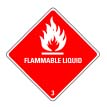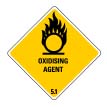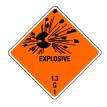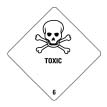This page tells you about dangerous goods, what you need to do to be able to carry them, and what you need to know.
For transport on land, dangerous goods include substances that have explosive, flammable, toxic, infectious, corrosive or environmentally hazardous properties, and containers that have held dangerous goods.
Commonly available goods that are classified as dangerous for transport include:
All classes of dangerous goods are described in table A of the Land Transport Rule: Dangerous Goods 2005 (the rule), which is based on classifications in the United Nations (UN) Recommendations on the transport of dangerous goods – model regulations.
Read the Land Transport Rule: Dangerous Goods 2005
Packages containing dangerous goods must be marked or labelled to identify their hazardous properties. This warns everyone who handles or transports the goods, or who finds the goods in an emergency situation.
For transport, dangerous goods are identified with a UN number, a proper shipping name and a diamond-shaped class warning label. Some products also have special marks to warn of hazards that are not indicated by other labels or marks. For example, products that are toxic to the aquatic environment are identified with the environmentally hazardous substance mark (a diamond-shaped symbol of a dead fish and tree).
Dangerous goods packaged for retail sale don't always have the diamond-shaped class label on the package, but are marked with warning information to identify the hazards they present.
Examples of dangerous goods placards:






Generally, if you're transporting dangerous or hazardous goods, you need a dangerous goods (D) endorsement on your driver licence.
A lot depends on what you're transporting, how much, and under what circumstances.
More information about D endorsements and how to get one
This information provides an overview only. If your business involves transporting dangerous goods, you must also refer to the rule. Printed copies of the rule are available from bookshops that sell legislation and some libraries.
Dangerous goods carried by transport service operators
Dangerous goods transported as tools-of-trade
Dangerous goods transported for domestic or recreational use
The rule details how you can transport dangerous goods safely and securely, depending on the nature and quantity of the dangerous goods.
Everyone involved in transporting dangerous goods has to comply with the rule. Responsibilities are allocated according to tasks, and you are responsible for all the tasks you do.
There are specific responsibilities for consignors (manufacturers, importers or distributors), loaders, drivers and operators of road or rail vehicles, and employers.
If you carry dangerous goods as tools-of-trade for agricultural use or for a commercial purpose, but not for hire or direct reward, and the quantity is within the limits in schedule 1 of the rule, then you are responsible for:
If you carry dangerous goods for domestic or recreational use, but not for hire or direct reward, and the quantity is within the limits in schedule 1 of the rule, then you are responsible for:
If you are a transport service operator, or if you transport dangerous goods for direct reward (eg a courier), you have specific responsibilities, set out in the rule, when transporting dangerous goods in small quantities. Small quantities of dangerous goods include the following:
The Land Transport Rule: Dangerous Goods Amendment 2010 introduced new provisions for dangerous goods in excepted quantities. These are very small quantities of low-danger products, eg 30 millilitres of perfume. There are also new provisions forexcepted packages of radioactive material, such as empty packaging or radioactive material in instruments and manufactured articles. Subject to the controls in clause 2.9 of the rule, these products can be carried without a dangerous goods declaration, segregation, placards or a driver licence endorsement.
Refer to section 2 of the rule for requirements for small packages, dangerous goods in excepted quantities and excepted packages of radioactive material.
You must comply with all the requirements of the rule if you carry dangerous goods as tools-of-trade, for agricultural use or for a commercial purpose, and the quantities are more than the limits in schedule 1 of the rule.
These include requirements for packaging, identification, documentation, segregation, placarding and driver licence endorsement.
When transporting dangerous goods for domestic or recreational use, you must comply with additional requirements in the rule if you carry more than the limits shown in schedule 1 of the rule. This includes additional requirements for packaging, labelling and marking, segregation and transport procedures – including emergency response information.
Transport service operators and other people who transport dangerous goods for direct reward have to comply with all requirements of the rule when transporting large quantities of dangerous goods.
Not everyone involved in dangerous goods transport will need technical information, but if you are a manufacturer, importer or distributor of dangerous goods, you will have to refer to one of the documents incorporated in the rule to meet your responsibilities. New Zealand Standard 5433:2012 Transport of dangerous goods on land (NZS 5433:2012) provides information on:
Download Factsheet 64: Transport dangerous goods [PDF, 608 KB]